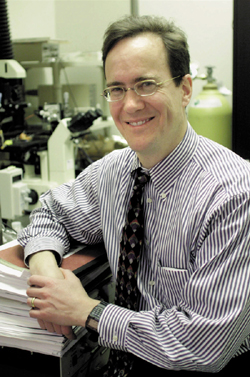
Dr. Mark Anderson is the lead author of the Circulation article explaining a molecular link to arrhythmias. (photo by Dana Johnson)
VUMC researchers discover molecular link to arrhythmias
In the aftermath of a heart attack, there is a flurry of remodeling activity. But this is no heart improvement job. Instead of repairing the damaged cardiac muscle, the structural and electrical remodeling renders the heart prone to arrhythmias — changes in the heartbeat that kill half of all individuals with heart disease.
VUMC investigators have a new molecular lead on what’s behind these deadly arrhythmias. Their studies, reported Sept. 3 in the journal Circulation, implicate a signaling molecule called calmodulin (CaM) kinase and suggest that drugs that block CaM kinase activity might make good anti-arrhythmic medications.
CaM kinase is a molecule that is intricately involved in calcium signaling and regulation, said Dr. Mark E. Anderson, Betty and Jack Bailey Professor of Medicine and associate professor of Medicine and Pharmacology. Calcium activates CaM kinase, and in turn, CaM kinase regulates calcium entry into the cell and calcium storage and release inside the cell. “CaM kinase is really right at the crossroads of calcium activity in the cell,” Anderson said.
This role makes CaM kinase an intriguing molecule for research related to heart disease, Anderson said, because “disordering of intracellular calcium homeostasis occurs in every known model of heart disease and in human heart disease.”
And recent studies have shown that CaM kinase activity is increased in animal models and human heart disease, he added. “So the question is, does CaM kinase — which we know is elevated in heart disease — drive arrhythmias?” Anderson said.
The investigators already had cellular evidence that this might be the case. Using isolated heart cells, they previously demonstrated that the addition of activated CaM kinase allowed more calcium than normal to flow into the cells. They also showed that cardiac cells with added CaM kinase had electrical changes called early afterdepolarizations (EADs).
“EADs are believed to be the triggering cause of arrhythmias in cardiomyopathy, hypertrophy, and long QT syndrome,” Anderson said. Long QT syndrome is a genetic or acquired disorder that predisposes patients to life-threatening cardiac arrhythmias.
To probe the role of CaM kinase in vivo, the investigators turned to a mouse model of cardiac hypertrophy developed by collaborators at the University of Texas Southwestern Medical Center. They showed that, as in other models of cardiac disease, CaM kinase activity was increased in these mice.
Tiny telemeters implanted into the mice allowed the investigators to record electrocardiograms (ECGs) — graphical recordings of the heart’s electrical activity. These recordings revealed not only the electrical changes expected in diseased hearts, Anderson said, but also an increased tendency for arrhythmias.
And treating the mice with a drug that blocks CaM kinase activity significantly suppressed the arrhythmias, Anderson said.
The investigators also examined cardiac cells isolated from the mice and found spontaneous EADs, which disappeared when the cells were treated with the CaM kinase-blocking drug. In addition, calcium channels — donut-like pores that let calcium cross the cell membrane — were more likely to be open in the mice with cardiac hypertrophy, allowing excess calcium to enter the cells. This change, too, disappeared in the presence of CaM kinase inhibitors, which in this case were specific cell membrane permeant peptides designed for this study.
At the level of molecules, cells, and animals, the evidence all points to CaM kinase driving arrhythmias, Anderson said, and to the possibility that drugs directed against the kinase would suppress arrhythmias. But because CaM kinase is widespread in the body and has so many different roles, it was not clear that it would be a useful target, he said.
“We’re excited because it looks like you can systemically administer CaM kinase inhibitors to block arrhythmias without causing serious side effects in the mice,” he said. Ongoing studies in Anderson’s laboratory are assessing long-term CaM kinase inhibitor treatment in mouse models with different kinds of heart disease.
Anderson and colleagues are also investigating the possibility that CaM kinase contributes to the remodeling activity that alters the diseased heart’s structural and electrical properties in the first place. CaM kinase is known to participate in signaling pathways that turn genes on and off, lending credence to the idea that it could help create the conditions of heart failure.
If the experiments show this to be the case, CaM kinase would become an even more important drug target, Anderson said. “We would love to have a target that addresses both of those phenotypes — the arrhythmia phenotype and the heart failure phenotype — and CaM kinase may be that target.”
Anderson holds a patent on the idea of using CaM kinase inhibitors to treat arrhythmias, and he is applying with Vanderbilt for a patent on the use of these drugs as treatments for structural heart disease. He is collaborating with a company to search for prospective CaM kinase inhibitor drugs.
“Half of the patients with heart disease die suddenly, because of arrhythmias,” Anderson said. And with the exception of so-called beta blockers, none of the current anti-arrhythmic drugs have been shown to reduce the mortality rate, he said. Some even increase the mortality rate. “Clearly, we have a lot of work to do to improve this situation,” Anderson said.
Anderson’s co-authors on the Circulation paper are Yuejin Wu, Joel Temple, Rong Zhang, Igor Dzhura, Wei Zhang, Robert Trimble, Dan M. Roden, Robert Passier, Eric N. Olson and Roger J. Colbran. The studies were supported by the National Heart, Lung, and Blood Institute and the American Heart Association.













